
Image Credit: EKF Diagnostics
Thanks to the increasing availability of point-of-care (POC) testing, the use of capillary blood (fingerstick) sampling worldwide is growing.
Anemia affects around 25% of the global population. Its prevalence is much higher in developing countries. In POC hematology, hemoglobin is the most commonly used test. It is also routinely used by blood collection services to ensure safe donations.
In the same instance, hemoglobin values are prone to pre-analytical errors. When drawing blood, healthcare professionals must adhere to strict and standardized blood sampling techniques. This is the best way to avoid generating variant and misleading hemoglobin results and to ensure accurate and consistent POCT results that are comparable to laboratory techniques.
In order to help health care professionals understand common causes of pre-analytical errors and reduce their impact on the hemoglobin result, below is a quick guide to capillary sampling best practice.
Understanding Common Causes of Pre-analytical Errors
A variety of physiological factors like dehydration, smoking behavior or altitude can cause variability in reported hemoglobin values. An incorrect capillary blood sampling technique can result in pre-analytical errors, which can also significantly affect hemoglobin values. The most common sources of error that healthcare workers should be aware of are detailed below.
- Correct choice of lancet – An adequate flow of blood is dependent on the lancet. It must make a sufficiently deep puncture. Depending on the thickness of the skin, 1.85 to 2.25 mm is recommended for adults. The penetration depth should not exceed 1.5 mm2 for children under the age of eight.
- Correct selection of puncture site – Ideally the middle or ring finger of the non-dominant hand should be used. These are usually less calloused and not as sensitive to pain compared to the index finger or thumb. There is also an artery present in the thumb so this should be avoided. The little finger has too small a distance between the skin surface and the bone.2 The puncture should be made in the fleshy portion of the fingertip, which is slightly off from the center. This is where the skin is thinnest and there are fewer nerve endings and, as such, less pain sensation. The best chance of good consistent blood flow and minimal pain for the patient are ensured if the correct finger and puncture site are selected.
- Cleaning, disinfection and drying – Any potential contaminants that may affect the reading or jeopardize patient safety need to be removed so cleaning and disinfection of the puncture site is essential. In order to ensure that all remnants of alcohol solution have been removed, the puncture site must be completely dried after cleaning. Any remaining alcohol solution will dilute the blood sample and cause false low readings.
- Applying too much pressure around the puncture site – Blood circulation can be stimulated by gently massaging the finger (not past the first knuckle) before and after the puncture. Effective penetration can be ensured by maintaining light pressure at the moment of puncture. However, fluid will be pushed from the tissue into the blood if the finger is pressed too hard, which will cause false low readings.
The Importance of Time and Blood Flow
Hemoglobin measurement is also influenced by capillary flow. A higher degree of variability in the hemoglobin concentration is typically shown in the first 1-3 drops after puncture. This is independent of the analytical device used for the test. For this reason the first few drops of blood should be wiped away.
The highest accuracy is usually achieved from the 4th drop after puncture and good capillary flow typically occurs for a period of 30-45 seconds. Coagulation will begin to occur after this point and blood clotting can lead to inaccurate hemoglobin results if a sample is taken after this occurs.
The presence of free spontaneous blood flow is the most important factor for reducing pre-analytical errors. The size of the drop and the time of collection following puncture are not well defined and manufacturers’ recommendations on this subject vary.
The effect of time and capillary blood flow on hemoglobin results
Figure 1. The effect of time and capillary blood flow on hemoglobin results. Image Credit: EKF Diagnostics
A Step-By-Step Guide for Best Practice Capillary Sampling
Accurate POC hemoglobin measurements can be achieved by following these steps when taking a capillary blood sample.
1. Ensure hands are properly clean before putting on well-fitting non-sterile gloves. All items for capillary sampling and performing the test should be close to hand.
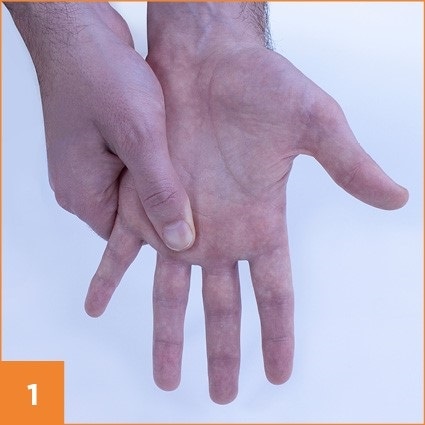
Image Credit: EKF Diagnostics
2. Take the non-dominant hand and select either the middle or ring finger. There must not be a ring on the finger as this may obstruct the blood circulation.
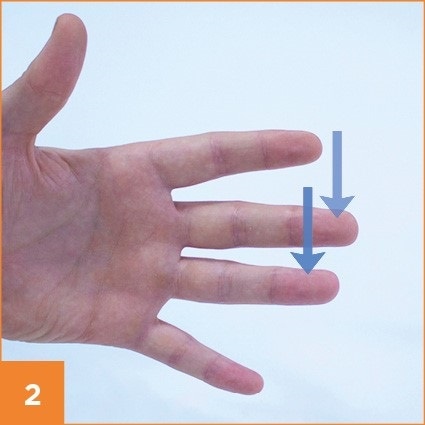
Image Credit: EKF Diagnostics
3. Ensure the patient is sitting comfortably and that their hand is warm and relaxed. The puncture should be made slightly off-center from the fleshy portion of the fingertip.
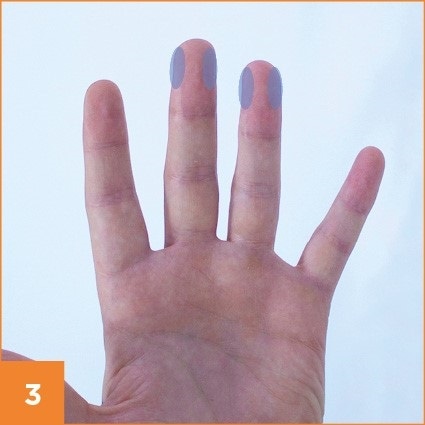
Image Credit: EKF Diagnostics
4. The puncture site should be disinfected and thoroughly dried.
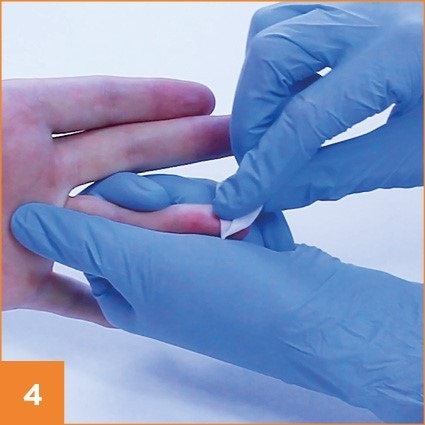
Image Credit: EKF Diagnostics
5. To increase blood flow gently massage the finger towards the tip but do not go past the first knuckle.
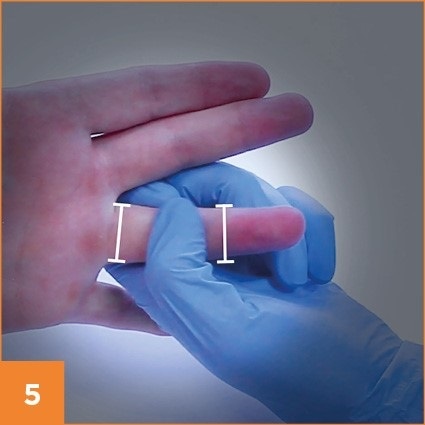
Image Credit: EKF Diagnostics
6. To facilitate filling of the hemoglobin cuvette, make the incision on the upward-facing side of the fingertip. Apply light pressure on the fingertip until a blood drop appears. The finger should not be pressed or milked. It sometimes takes a few seconds for the blood to start flowing after the puncture.
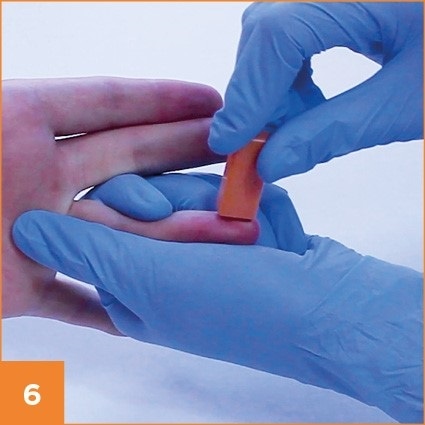
Image Credit: EKF Diagnostics
7. The first 2-3 drops should be wiped away and blood should be flowing freely before filling the cuvette. When wiping off a drop release the grip on finger.
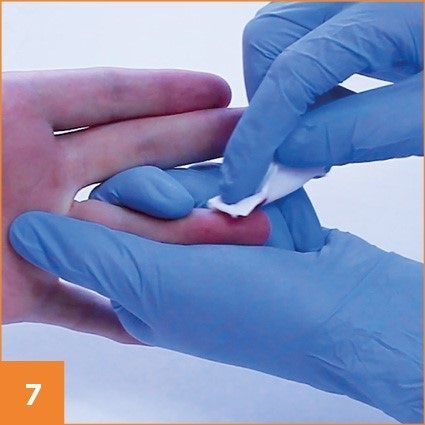
Image Credit: EKF Diagnostics
8. Ensure a sufficient sized blood drop is available to fill the cuvette. The cuvette should be completely filled in one go. It should not be refilled and air bubbles should be avoided. The Instructions for Use provided by the manufacturer of the hemoglobin analyzer should always be referred to.
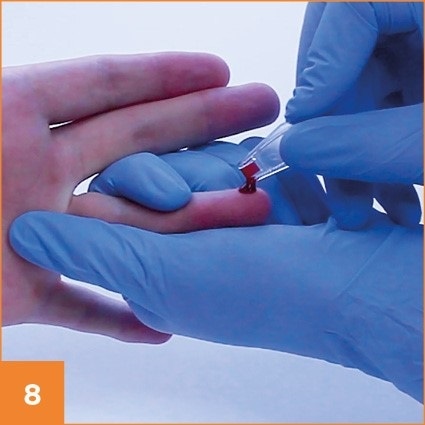
Image Credit: EKF Diagnostics
References
- Ernst DJ, Balance LO, Calam RR, McCall R, Szamosi DI, Tyndall L. Procedures and Devices for the Collection of Diagnostic Capillary Blood Specimens. 6th ed. Approved Standard GP42-A6. Wayne, Pa: Clinical and Laboratory Standards Institute, 2008. Available at: https://clsi.org/standards/products/general-laboratory/documents/gp42/. Accessed July 6, 2017.
- Dhingra N, Diepart M, Dziekan G, et al. “Capillary Sampling,” in WHO Guidelines on Drawing Blood: Best Practices in Phlebotomy. Geneva, Switzerland: World Health Organization, 2010.
- Briggs C et al, Where are we at with point- of- care testing in haematology? British Journal of Haematology, 2012, 158, 679–690
- Massimo Daves et al, Evaluation of capillary haemoglobin determination for anaemia screening in blood donation settings Blood Transfus. 2016 Sep; 14(5): 387–390.
About EKF Diagnostics
EKF Diagnostics is a global medical diagnostics business with a long history in point-of-care testing and central laboratory manufacturing. Our products have a hard earned reputation for ease of use, reliability and accuracy.
Our core focus is the Point of Care market with over 80,000 haemoglobin, A1c, glucose and lactate analyzers in regular use in more than 100 countries running more than 50m tests every year.
Our range of HbA1c analyzers and glucose analyzers are used in GP surgeries, sports clinics, and diabetes clinics. They deliver fast and reliable results that provide both practitioner and patient with the information they need to make clinical or lifestyle decisions in minutes.
EKF Diagnostics offer the largest range of hemoglobin and hematocrit analyzers on the market, giving physicians and specialists a choice of product with different methodology, measurement speed, connectivity and price options. Our aim is to make blood donation and anaemia screening easier, more affordable and more accessible than ever before.
The EKF Maternal & Women’s Health Point of Care range aims to improve healthcare outcomes for women and children by providing physicians with a suite of products covering pregnancy testing, anaemia screening, fetal scalp lactate testing and post birth creamatocrit measurement.
EKF Diagnostics is also a global manufacturer of central laboratory products including Stanbio Chemistry reagents, benchtop laboratory analyzers, rapid tests and centrifuges. Our chemistry reagents can be used on the majority of analyzers found in hospital laboratories around the world.
The ordinary shares of EKF Diagnostics Holdings plc are traded on the AIM market of the London Stock Exchange.
Sponsored Content Policy: News-Medical.net publishes articles and related content that may be derived from sources where we have existing commercial relationships, provided such content adds value to the core editorial ethos of News-Medical.Net which is to educate and inform site visitors interested in medical research, science, medical devices and treatments.